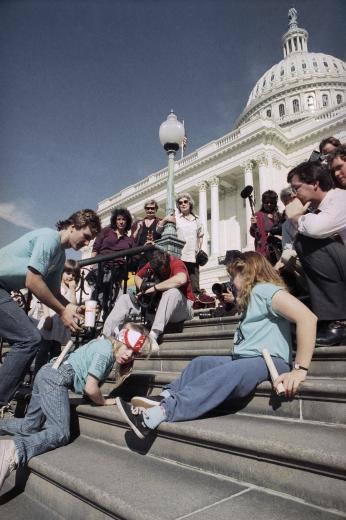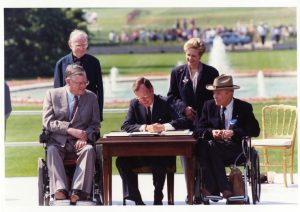July 26 marks the signing of the Americans with Disabilities Act (ADA) by President George H.W. Bush. The unprecedented law, enacted in 1990, affirmed the rights of the disabled, making public spaces, places of employment and transportation less discriminatory. Significant changes across the public and private sectors were needed so disabled individuals could fully participation in public and economic life in the United States.
The passage of the ADA was preceded by years of activism and advocacy-group efforts.
That March, for example, more than 1,000 people marched from the White House to the U.S. Capitol, and then roughly 60 people relinquished their walkers and other mobility aids to crawl up the Capitol steps as part of the protest. It became known as “the Capitol Crawl.”

Before the ADA,
- Public transportation, such as trains, were not required to have handicap access.
- Businesses, and even libraries, could refuse to serve disabled individuals.
- Businesses could refuse to hire the disabled.
- Offices and other buildings were not required to have ramps, elevators or automatic door openers.
- Entertainment venues, such as theaters and stadiums, were not required to have wheelchair spaces.
Because these items were voluntary, they usually did not exist, and disabled individuals often were excluded from public and economic life.
“Let the shameful wall of exclusion finally come tumbling down,” President Bush said at the signing.

In the Years Since
In 2020, the ADA turned 30 years old, and the day was marked by historical accounts and reflections about how life has changed for people with disabilities and how our perception of the disabled has changed, in large part because of the ADA.
In the present day, ADA regulations continue to evolve, as advocates push for increased access to all parts of public life. That is especially important as technology changes and plays a bigger role in society. In April of this year, the Department of Justice issued a groundbreaking and very necessary update to ADA regulations that requires web content and mobile applications to be accessible to people with disabilities.
Photography by Jeff Markowitz, courtesy AP Photo; second photo courtesy of the George Bush Presidential Library and Museum/NARA





Leave a Reply
You must be logged in to post a comment.